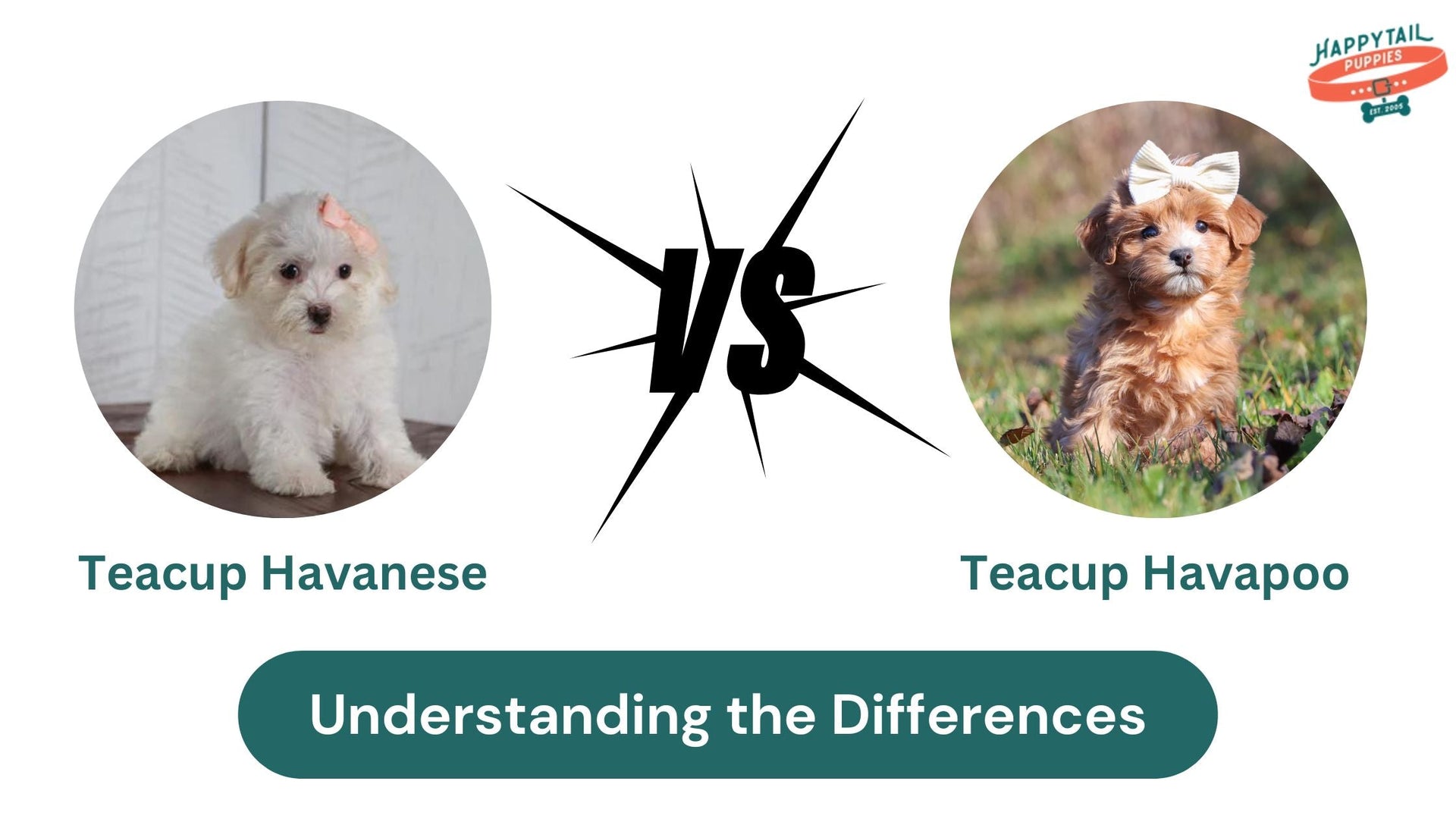Teacup Havanese Vs. Teacup Havapoo: Understanding the Differences
Due to their size, there are so many types of dogs that choosing the best dog type can be quite complicated at times. Other than their temperament and coat type, it forms the real decision between pure and hybrid breeds as compared to Havapoo and Havanese.
Both breeds are similar to each other in many ways. The real difference lies in the fact that there is a difference between the appearance of both breeds since the Havapoo is a hybrid formed with the mix of a Havanese and a Poodle, and it is the part that Havapoo gets. Each of the breeds has its past as they vary in terms of their temperaments, physical traits, type of coat, trainability, and more. In this article, we compare and contrast these two great breeds; in addition to that, we consider the background of both.
About Havanese
The Teacup Havanese is also a toy breed, and this dog is friendly and playful by nature. Since the Havanese are one of the parents of the Havapoo, all the physical traits, including hair and color and even temperament, of Havapoo are therefore attributed to the Havanese! Originating from Cuba, The Havanese is a purebred dog, and therefore, its history is quite colorful.
The Havanese breed was nearly eradicated mainly because of political instabilities in Cuba in the 20th century. Fortunately, a few Havanese dogs were taken to the United States and Europe by refugees, where breeders succeeded in breeding them.
About Havapoo
The Teacup Havapoo, also known as the Havadoodle, Poovanese, or Havanoodle, is a relatively new design hybrid breed. It originated from the breeding of the Havanese and the Poodle, both of which are loved and known dogs of small size. Havanese is an antique Cuban dog breed that became companion dogs for the wealthy. On the other hand, Poodles originated in Germany, where they were used as water retrievers, and later, they were bred for aristocratic usage in France.
Poodles are divided into three categories according to their sizes. Their fur is curly, and they do not cause allergies in people. Almost all the Havanese breeds faced the risk of being extinct after the Cuban revolution but were revived by Havanese of Cuban origin who were brought to the United States with the aim of starting a breeding farm. The Havapoo has yet to be widely known where it came from. However, the breeding of Havapoos was said to have been done during the fad of breeding hybrid Poodles in the 1980s.
Key Characteristics
Havanese
- Average height (adult): 8–13 inches
- Average weight (adult): 7–13 pounds
- Lifespan: 13–16 years
- Exercise: 30 minutes a day
- Grooming needs: High
- Family-friendly: Yes
- Other pet-friendly: Often
- Trainability: Intelligent, eager to please, energetic, occasionally stubborn
Havapoo
- Average height (adult): 8–15 inches
- Average weight (adult): 7–30 pounds
- Lifespan: 14–16 years
- Exercise: 1 hour a day
- Grooming needs: Moderate
- Family-friendly: Yes
- Other pet-friendly: Often
- Trainability: Intelligent, energetic, playful, quick to learn
Havanese vs. Havapoo Comparision
Appearance

Havanese: The Teacup Havanese is a petite dog breed with a lengthy coat that is often straight or wavy. Compared to Havanese, poodles are larger, so the Havanese is a tad smaller than the Havapoo, reaching heights of about 8-13 inches in height and weighing in at a weight of 7-13 pounds. Of course, they have appealing mouths and facial expressions, which includes small dark almond-like eyes and a black and wet nose. The breed is available in many colors white, brown, black, tan, and other combinations of these colors.
Havapoo: Due to the fact that Havapoos are mixed breed dogs, they might have some distinctive features from the parents depending on the amount of Poodle and Havanese cover-up. They are small-sized dogs that range from 7 – 30 pounds on the scale and have heights of 8 –15 inches. They have long, curly, non-shedding hair and can be found in black, white, brown, cream, tan, gray, brindle, or any combination of these. With floppy ears, large round eyes, and a compact-n-tough build, they look as cute as buttons!
Personality & Temperament
Havanese: Similar to Havapoo, the Havanese are friendly dogs that are intelligent, affectionate, and very active! Originally developed in Cuba for pets, the Havanese enjoy being around their owners and are good with the kids as well. They are very hug and like to be the focus of everything, thus they may bark to capture your attention.
Havapoo: As for character, the Havapoo is pleasant, friendly, devoted to the owner, and fond of spending time together. Its temper, like its physical appearance, is that Havapoos have of friendly, sociable temper and tend to mingle well with strangers and the other pets. These dogs are smart and can easily be trained, making it possible for first-time owners to handle them. Havapoos are also playful and energetic; however, they are suited for apartments or small houses provided that they are taken out for exercise and their brains are exercised as well.
Grooming Requirements
Havanese: The Havanese is known to have long, silky fur. Thus, grooming is often exercised, particularly on its fur. They are considered minimal shedders; however, you still need to brush them twice to three times a week and bathe them occasionally. Their coats also need to be trimmed from time to time so they do not become too long, which can be rather uncomfortable for the dog.
Havapoo: Like the Poodle and Havanese, the Havapoo has a cute, lush, curly, non-shedding coat that is described as hypoallergenic. Although the Havapoo is a non-shedding breed, it will still need to be regularly brushed two to three times a week and professionally groomed within one to two months.
Training
Havanese: Havanese dogs are highly intelligent and playful, which is why they can never get bored when learning new things. They are active and like to be around people; hence, constructive criticism is essential when training this breed. Sometimes, they can span insolently and can also be bull-headed and may not easily adapt to changes; hence, proper training of the Havanese should start at an early age by exposing them to various places, people, or other pets they are likely to come across.

Havapoo: Havapoos are highly intelligent but very friendly dogs That must undergo early training and socializing to become the ideal family companion. They are intelligent canines who learn tricks well, and they would be suitable for first-time pet parents. They can only respond best to encouragement and would be eager learners of new tricks.
Best For
Havanese: They are small-sized dogs, which makes them ideal for being housed in homes and apartments. However, one has to take caution that Havanese are often frequent barkers and thus may not be suitable for quiet areas or apartments. They are also good breeds for consideration by people with dog allergies since they are classified as hypoallergenic dogs.
Havapoo: Also known as Teacup Havapoo, these dogs are friendly, energetic, and highly intelligent, which makes them an excellent choice for owners who have little to no experience with dog training. They are good companion dogs, suitable for families with kids, and acceptable as a multi-pet home. Due to their size, the dogs can be easily raised in both big houses and small apartments. They are equally good for individuals with allergy problems because they do not affect them in any way.
Which Breed Is Right for You?
The Havapoo and Havanese are medium-sized dogs that are great for families and can easily adapt to living in small homes. They are also perfect for people with allergies, whether combined with any home. The Havapoo can be slightly larger and slightly easier to train than the more willful and vigorous barker, the Havanese. However, both breeds of dogs are easily prone to depression and separation anxiety and cannot be left alone for very long.
Frequently Asked Question
What Is So Special About Havanese Dogs?
Havanese are outgoing, friendly dogs who develop well in tricks and performing arts due to their natural comedic talent. They are also very effective watchdogs but do not make light of the job, though they keep the noise to a minimum in cases of intruders.
Which Is Better, Cavapoo or Havanese?
Havapoos are not as energetic as Cavapoos and, as a result, are better for civilized folk who don’t want to take their dogs jogging or running.
How Do a Havapoo and a Havanese Differ?
The Havanese is one of the most popular and recognized purebred dogs, while the Havapoo is a cross between the Havanese and the Poodle.
Are Havapoos Aggressive?
These are cheerful and pleasant dogs whose character is cheerful and playful. They also possess a consistent personality that is intelligent, kind, and a boon to have around the family.
Do Havapoos Like to Cuddle?
If you are searching for a partner who is passionate and ardently wishes to hug as much as to complete a stunt, the Havapoo could be the heat you have been seeking.
Final Thoughts
There is no option choosing between Havanese and Havapoo as the issue is not which breed is better, but where the shades of each breed match your temperament and expectations of the pet. At Happytail Puppies, we offer the ideal puppies for sale. Nevertheless, everyone should focus on the fact that every dog, regardless of breed, has the greatest individuality.
- Teacup Havanese
- Teacup Havapoo


